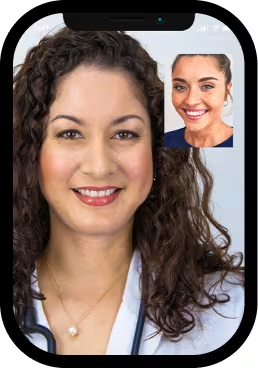- Chronic Care
Lyme Disease
Lyme disease treatment available online today
Request Lyme disease treatment today from our trusted, board-certified online doctors and get relief from pain and uncomfortable symptoms today. Get a new prescription for Lyme disease or refill an existing prescription today. Our doctors can also refer you to the nearest specialist for further treatment if needed.*
Book an appointmentExpert screening for Lyme Disease
Help relieve pain and fatigue
Effective prescriptions for Lyme Disease
*Prescriptions are provided at the doctor's discretion. Learn more about our controlled substances policy and how to save up to 80% with our prescription discount card. PlushCare doctors cannot treat all cases of lyme disease. Our primary care physicians can conduct an initial evaluation of your symptoms but may need to refer you to a specialist or for in-person treatment. If you are experiencing life-threatening symptoms, seek emergency medical attention immediately.

Learn about Lyme disease
Lyme disease is a bacterial infection transmitted through the bites of an infected tick. The black-legged tick, commonly known as the deer tick, is the primary transmission vector in the United States.
People living around wooded areas and hikers are prone to getting tick bites and getting infected. Early Lyme disease diagnoses include rash, fever, and headache. Early treatment can help with quick recovery.
Lyme disease causes
The bacterium Borrelia burgdorferi and Borrelia mayonii are typically the leading cause of Lyme disease in the United States. These bacteria live in ticks and are transmitted to humans when the ticks bite the host, in this case, the human. In the United States, deer ticks are typically found in these regions:
Pacific coast (i.e., northern California)
North Central United States
Northeast
Upper Midwest
Mid-Atlantic
The infected black-legged ticks often attach to unsuspecting hikers or people traveling through wooded areas. Due to their small size, it is hard to spot ticks. When tick bites happen, the bacteria enter the human bloodstream through broken skin tissues. The longer a tick is attached to the host, the higher the likelihood of Lyme disease transmission (typically 36-48 hours).
Lyme disease symptoms
Lyme disease symptoms can vary depending on the stage of infection (i.e., early stage, later stage).
Early-stage symptoms
Early-stage Lyme disease symptoms typically appear between 3 and 30 days after a person is bitten by an infected tick. Below some common symptoms are described.
Erythema migrans (EM) rash is a distinctive symptom of Lyme disease that most people get. The rash begins at the site of the tick bite and slowly expands over the course of a few days, reaching approximately 12 inches (30 cm) across. EM rash is typically not painful or itchy but can feel warm. As the rash clears from the initial bite area while it expands, a target or “bull’s-eye” appearance can be observed.
Other early-stage symptoms include muscle and joint aches, headache, fever, chills, swollen lymph nodes, and fatigue.Later stage symptoms
If left untreated and allowed to progress into a later stage, more severe symptoms of Lyme disease can begin to manifest. These symptoms can show up weeks to months after observing early-stage Lyme disease symptoms. Later stage symptoms include:
Additional EM rashes on other areas of the body
Heart problems, such as irregular heartbeat or palpitations
More severe headaches and neck stiffness than in the early stage
Facial palsy (loss of muscle tone or droop on one or both sides of the face)
Inflammation of the brain and spinal cord (i.e., meningitis)
Nerve pain
Lyme arthritis, which refers to severe joint pain and swelling, particularly in the knees and other large joints

How to treat Lyme disease
Given the bacterial nature of Lyme disease, the most effective treatment is antibiotic treatment. The earlier the treatment is administered, the faster and higher the chance of a full recovery without lingering effects.
Unfortunately, after treatment, some patients suffer persistent symptoms such as pain, fatigue, or difficulty thinking for 6 months or more. These persistent symptoms are called post-treatment Lyme disease syndrome (PTLDS).
Currently, there is no known treatment for post-treatment Lyme disease syndrome. Work with your healthcare provider to develop an effective plan to manage the post-treatment Lyme disease syndrome.
Medication for Lyme disease
Oral antibiotics
When diagnosed or detected early, oral antibiotics are a go-to treatment. A 2-3 week course is usually prescribed. Adults and children are prescribed different antibiotics.
Adults: doxycycline
Children: amoxicillin
When prescribed early, oral antibiotic treatment is effective on the following Lyme disease symptoms:EM rash
Lyme arthritis
Facial palsy
Lyme meningitis/radiculoneuritis, depending on severity, as more severe forms require intravenous antibiotic treatment
Lyme carditis, depending on severity, as more severe forms require intravenous antibiotic treatment
Intravenous antibiotics
For Lyme disease symptoms involving central nervous systemic infection symptoms, intravenous antibiotic therapy is the preferred treatment. Your doctor will prescribe intravenous antibiotic therapy for the following Lyme disease symptoms:
Lyme meningitis/radiculoneuritis
Lyme carditis
Typical treatment periods last anywhere from two to three weeks.

How to prevent Lyme disease
The best way to prevent Lyme disease is to actively reduce exposure to ticks and incidences of tick bites.
Before going outdoors
Avoid wooded, grass, or brushy areas when hiking, as ticks tend to live in these areas.
Apply insect repellent with DEET.
Treat outdoor clothing and gear with repellent containing 0.5% permethrin.
Upon returning indoors
Check clothing and gear to remove any ticks found. Tumble dry clothes in high heat for at least 10 mins to kill ticks.
Check for ticks on your body, particularly in and around ears and hair, under the arms, around the waist, between the legs, and the back of the knees.
Shower as soon as possible upon return. The CDC recommends showering within two hours of returning indoors to reduce the risk of tickborne diseases.

When to see a doctor for Lyme disease
The longer the tick attaches to you, the higher the probability of getting bitten and infected. However, note that most tick bites do not lead to Lyme disease. Do visit your doctor if any of the following conditions apply to you:
You think you have been bitten by ticks
You are displaying symptoms of Lyme disease
You were hiking in an area where Lyme disease is common
Continue to follow up with the doctor even if the symptoms have receded. The disease may not be fully eradicated, even if the symptoms have disappeared. Follow up with your doctor to confirm.
Lyme disease treatment FAQs
What is the best treatment for Lyme disease?
The most effective treatment for Lyme disease is a course of antibiotics. The earlier the treatment is administered, the faster and higher the chance of a full recovery without symptoms of late-stage Lyme disease.
However, aside from prompt treatment, prevention is the best treatment. The best way to prevent Lyme disease is to avoid tick bites. Before going outdoors, apply insect repellent with DEET or treat outdoor clothing and gear with repellent containing 0.5% permethrin. Upon returning from the outdoors, check the body, clothing, and gear for ticks.What is the best medication for Lyme disease?
Generally, the best medication for Lyme disease is a course of antibiotics. Depending on whether you have early or late-stage symptoms, oral or intravenous antibiotics can be prescribed. When treated early, oral antibiotic treatment is effective on Lyme disease symptoms such as EM rash, Lyme arthritis, and facial palsy. For neurologic Lyme disease symptoms, intravenous antibiotic therapy is the preferred treatment.
Can Lyme disease completely be cured?
When antibiotic treatment is prescribed at the onset of early symptoms, most patients experience a high chance of full recovery without symptoms of late-stage Lyme disease. If the disease is allowed to progress into the late stage, the damage to the nervous system and joints may become chronic.
Can you treat late-stage Lyme disease?
Yes. Antibiotics will be effective in treating late-stage Lyme disease. However, some patients will continue to suffer the effects of damage to the joints and nervous system, such as Lyme arthritis.
Can you get rid of Lyme disease without antibiotics?
No, due to the bacterial nature of Lyme disease, antibiotic therapy is critical. Without antibiotic treatment, the bacteria will continue to attack the immune and nervous systems.
What is post-treatment Lyme disease syndrome?
Post-treatment Lyme disease syndrome (PTLDS) refers to the persistent symptoms, such as pain, fatigue, or difficulty thinking for 6 months or more, that some patients continue to suffer after treatment.
Unfortunately, there is no known treatment for post-treatment Lyme disease syndrome. Patients typically continue to work with doctors to develop an effective plan to manage the post-treatment Lyme disease syndrome.
3 simple steps to request Lyme disease treatment

Step 1
Book a Lyme disease treatment appointment.
Book a same day appointment from anywhere.

Step 2
Talk to your medical provider regarding your Lyme disease symptoms.
Visit with a doctor on your smartphone or computer.

Step 3
Pick up prescription for Lyme disease treatment.
We can send prescriptions to any local pharmacy.
Related conditions to Lyme disease
Several medical conditions display similar symptoms to Lyme disease:
Influenza
Symptoms of early-stage Lyme disease, such as fever, chills, and pain, are flu-like symptoms.
Cellulitis
This is a bacterial infection in which the infected area is inflamed, tender, red, and swollen, and it can be commonly mistaken for Lyme disease.
Rheumatoid arthritis
Lyme disease treatment pricing details
How pricing works
To request Lyme disease treatment and get a new or refill on your prescription, join our monthly membership and get discounted visits
Paying with insurance
Membership
$16.99/month
First month free
Visits
Copay
30 days of free membership
Same-day appointments 7 days a week
Unlimited messages with your Care Team
Prescription discount card to save up to 80%
Exclusive discounts on lab tests
Free memberships for your family
Cancel anytime
Visit price with insurance
Often the same as an office visit. Most patients with in-network insurance pay $30 or less!
We accept these insurance plans and many more:
Paying without insurance
Membership
$16.99/month
First month free
Visits
$129
30 days of free membership
Same-day appointments 7 days a week
Unlimited messages with your Care Team
Prescription discount card to save up to 80%
Exclusive discounts on lab tests
Free memberships for your family
Cancel anytime
Visit price without insurance
Initial visits are $129.
If we're unable to treat you, we'll provide a full refund.
Lyme disease treatment resources
Sources:
PlushCare is dedicated to providing you with accurate and trustworthy health information.
Centers for Disease Control and Prevention. "Lyme Disease." Accessed 25 Sept. 2023. www.cdc.gov/lyme/index.html.
MedlinePlus. "Lyme Disease." Accessed 25 Sept. 2023. https://medlineplus.gov/lymedisease.html
Mayo Clinic Staff. "Lyme Disease." Accessed 25 Sept. 2023. https://www.mayoclinic.org/diseases-conditions/lyme-disease/symptoms-causes/syc-20374651
PlushCare content is reviewed by MDs, PhDs, NPs, nutritionists, and other healthcare professionals. Learn more about our editorial standards and meet the medical team. The PlushCare site or any linked materials are not intended and should not be construed as medical advice, nor is the information a substitute for professional medical expertise or treatment.